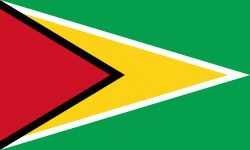Guyanese dollar
$
The Guyanese dollar (currency sign: $, G$ and GY$; ISO: GYD) has been the unit of account in Guyana (formerly British Guiana) since 29 January 1839. Originally it was intended as a transitional unit to facilitate the changeover from the Dutch guilder system of currency to the British pound sterling system. The Spanish dollar was already prevalent throughout the West Indies in general, and from 1839, the Spanish dollar unit operated in British Guiana in conjunction with British sterling coins at a standard conversion rate of one dollar for every four shillings and twopence. In 1951 the British sterling coinage was replaced with a new decimal coinage which was simultaneously introduced through all the British territories in the Eastern Caribbean. When sterling began to depreciate in the early 1970s, a switch to a US dollar peg became increasingly attractive as an anti-inflationary measure and the Eastern Caribbean Currency Authority (of which Guyana was a member) made the switch in October 1975. The Guyanese dollar is normally abbreviated with the dollar sign $, or alternatively G$ (Guyanese Dollar) to distinguish it from other dollar-dominated currencies.The history of the Guyanese dollar should not be considered in isolation of the wider picture surrounding the history of currency in the British West Indies as a whole. ( See Currencies of the British West Indies ). The aspects of that history that are peculiar to British Guiana are the continued use of the four pence groat coin when all other territories had abandoned it, and also the use of dollar accounts in both the public and private sectors since 1839. In the other Eastern Caribbean territories, there was a mixture of dollar and sterling accounts until the year 1951.
The Dutch territories of Essequibo, Demerara, and Berbice on the north coast of South America, created in early 17th century, came under the control of the British during the Napoleonic wars. These territories were formally ceded to the United Kingdom in 1815 and united to become the colony of British Guiana in 1831. At first, the British introduced a British variety of the Dutch guilder currency into this territory. Then in 1839, the Spanish dollar as a unit of account was introduced in order to facilitate the introduction of British sterling silver coinage. The rationale behind this lies in the fact that Spanish silver dollars, alternatively known as pieces of eight, were already circulating alongside the Dutch coinage, and also widely throughout the Eastern Caribbean. The dollar unit of account therefore acted as a convenient intermediary conversion unit between sterling and the outgoing guilder unit. The dollar unit was equivalent to 4 shillings 2 pence sterling and replaced the guilder unit at a rate of 1 dollar = 3 1⁄8 guilders, i.e. £1 = $4.80 = 15 guilders.
A particular feature of the circulation of British silver coins in British Guiana was the popularity of the 4d (four pence) coin, known as the groat. This was a direct consequence of its equivalence to the very popular outgoing 'bit' coin which was equal to one quarter of a guilder. When the groat coin ceased to circulate in the United Kingdom in the latter half of the nineteenth century, a special request was made in 1888 for groats to be struck for use in the British West Indies and British Guiana. These were first struck in 1891. From 1917 they were struck exclusively for use in British Guiana.
Spanish, Mexican, and Colombian silver dollars continued to circulate alongside the British sterling coinage until 1876 when these dollar coins were demonetised.
The Spanish dollar unit should not be confused with the American dollar unit. The American dollar unit was first introduced in the US in the year 1792, based on the average weight of a selection of worn Spanish dollars. As such, the American dollar was marginally less valuable than the Spanish dollar.
Country
-
Guyana
Guyana, officially the Cooperative Republic of Guyana, is a country on the northern mainland of South America. Guyana is an indigenous word which means "Land of Many Waters". The capital city is Georgetown. Guyana is bordered by the Atlantic Ocean to the north, Brazil to the south and southwest, Venezuela to the west, and Suriname to the east. With 215000 sqkm, Guyana is the third-smallest sovereign state by area in mainland South America after Uruguay and Suriname, and is the second-least populous sovereign state in South America after Suriname; it is also one of the least densely populated countries on Earth. It has a wide variety of natural habitats and a very high biodiversity.
The region known as "the Guianas" consists of the large shield landmass north of the Amazon River and east of the Orinoco River known as the "land of many waters". Nine indigenous tribes reside in Guyana: the Wai Wai, Macushi, Patamona, Lokono, Kalina, Wapishana, Pemon, Akawaio and Warao. Historically dominated by the Lokono and Kalina tribes, Guyana was colonised by the Dutch before coming under British control in the late 18th century. It was governed as British Guiana, with a mostly plantation-style economy until the 1950s. It gained independence in 1966, and officially became a republic within the Commonwealth of Nations in 1970. The legacy of British rule is reflected in the country's political administration and diverse population, which includes Indian, African, Indigenous, Chinese, Portuguese, other European, and various multiracial groups. In 2017, 41% of the population of Guyana lived below the poverty line.
